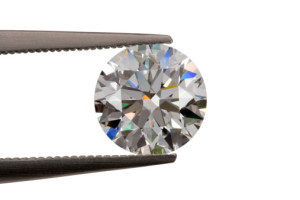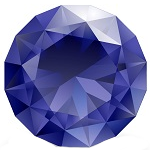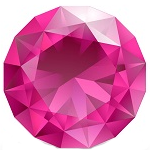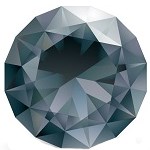Diamonds

For almost 6,000 years, diamonds have been highly prized by artisans for their brilliance
as ornaments of adoration, and equally prized for their use as the most valued tools
in construction and art. Because diamonds are one of the hardest known substances
on Earth, and can disperse natural light into spectral brilliance, the availability
of diamonds was highly restricted.
In the early 19th Century, the discovery of large diamond deposits and
the continuous improvement in the cutting and polishing of diamonds vastly increased
their popularity and desirability. As most diamond mines are nationalized
or controlled by conglomerates, the competition for control of the industry led
to the current system of grading diamonds, a system known as the four Cs.
The four characteristics upon which a diamond is rated as a gemstone include color,
cut, clarity, and carat. While diamonds naturally occur
in a range of colors in hues from blue to black and pink to purple, the vast majority
of diamonds are typically colorless to hues of yellow, grey and brown. Gem
quality diamonds’ color is rated on an alphabetical scale ranging from D (white)
to Y (yellow). “Z” diamonds are fancy, or deep-colored diamond. The cut of
a diamond is rated on how it maximizes the stone’s ability to reflect light, or
its “fire”. A diamond’s clarity rates the size and number of its flaws and inclusions
(such as black carbon flecks) from what can be seen with the naked eye to 10 times
magnification. Carat refers specifically to a diamond’s weight.
Gemstones
Gemstones are minerals that have become prized and valued according to their rarity,
and specific characteristics for each stone such as its color(s), durability, ability
to be cut into specific shapes, as well as other factors such as its ability to
disperse light. Diamonds, sapphires, emeralds and rubies have been classified
as precious gemstones; all other minerals in this category are classified as semi-precious
gemstones. A few non-mineral organic materials such as coral, amber, and pearls
have been designated as gemstones.
While gemologists have designated about 30 minerals as gemstones, the international
designation of birthstones or gemstones associated with each month of the year has
made the following gemstones among the most popular:
January: Garnet is a form of silicate that is most common in hues
of red

February: Amethyst is a form of quartz that develops in hues of
purple

March: Aquamarine is a form of beryl named for its light sea-blue
color

April: Diamond

May: Emerald is a form of beryl that is green

June: Pearl

July: Ruby is a form of corundum. Only diamonds are harder
than rubies

August: Peridot is a clear yellow-light green olivine. Objects
viewed through. Peridots appear to be double.

September: Sapphire is a form of hard corundum that is most
common in hues of blue

October: Opal is an opaque form of quartz whose inclusions
reflect multiple colors

November: Topaz is a hard, clear silicate that is desired
in brown, orange, and light blue

December: Zircon, is the traditional stone for December; however,
Tanzanite, a calcium-aluminum silicate, has been added as an additional birthstone
for the month of December

Natural Gemstones
Our precious and semi-precious gemstones are natural. To achieve the designer’s
artistic vision, gemstones may appear in their rough, natural state, be polished,
be cut into shapes, be partially or fully faceted, or enhanced to improve their
color and clarity.
Enhanced Gemstones
Gemstones are enhanced in laboratory conditions. Heat and radiation is used
to change the color and clarity of gemstones, while diffusion is used to deepen
the color of gemstones.